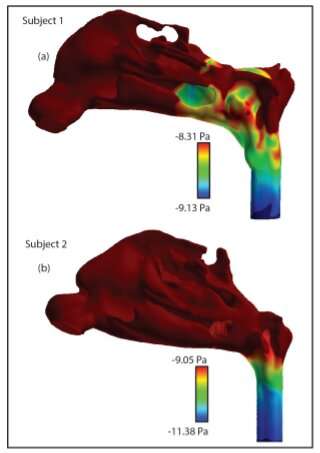Inhaling virus-laden droplets may increase COVID-19 severity

Whether COVID-19 becomes a life-threatening disease depends, in part, on the virus reaching one's lungs. Scientists suspect the initial infected tissues in the upper airway can act as the source for virus-laden droplets or boluses, that are aspirated into the lungs. That could explain the brisk pace at which the infection spreads to the lungs in some patients, shortly after the COVID-19 symptoms appear.
Assistant professor Saikat Basu of South Dakota State University's Department of Mechanical Engineering is part of a multi-institutional group that investigated whether the novel coronavirus might be invading the lungs through this mechanism.
Basu and researchers from the School of Medicine at University of North Carolina at Chapel Hill, the School of Public Health at Boston University and Fractal Therapeutics, a drug development company, found the amount of virus that can potentially be aspirated into the lungs is thousands of times more than the dose needed to spread the infection to susceptible cells in the lower airway.
"These are preliminary findings (of a small study), but the results are in good agreement with our previous work as well as the work done by other researchers on aspiration rates," said Basu. He has been modeling aerosol transport in the human respiratory tract to investigate SARS-CoV-2 transmission, improve delivery of nasal therapeutics, prophylactics and vaccines and develop a mask that captures and deactivates the virus. The research is supported, in part, by a National Science Foundation RAPID grant for COVID-19 research.
Basu has also been doing similar aerosol and drug delivery modeling to help patients with chronic sinus problems with the UNC Chapel Hill School of Medicine research group for nearly six years.
An article detailing the results was recently released in Rhinology Online, an open-access, peer-reviewed journal published by the European Rhinologic Society. "This is one of the top journals in the ENT community and perhaps the first time clinicians have directly reviewed our COVID-related work prior to publication," Basu said.
Figuring out how the infection spreads from the upper airways to the lungs can help health care professionals identify patients at higher risk for severe disease.
Analyzing infectivity
The site where a sore throat occurs—the cavity behind the nose and mouth and above the esophagus, known as the nasopharynx—is the entry point of the novel coronavirus, explained Basu. His earlier modeling work on virus-laden droplets, along with studies at UNC Chapel Hill and Oxford University, amongst others, have confirmed this.
Other studies have assessed viral load in the saliva of COVID-19 patients. In previous work, Basu estimated the minimum number of virus particles needed to trigger the infection, known as the infectious dose, to be about 300 viral particles or virions.
Other research studies determined a person swallows 500 to 700 times including while eating and drinking during the day and 24 times at night. Approximately 12% of those swallows result in tiny droplets from the upper airway entering the lungs, Basu said. That means a person inhales tiny droplets 60 to 84 times while awake and three times while sleeping.
Using the droplet sizes and inhalation frequency, Basu did aerosol transport modeling using CT scans of human airways. Results showed a person infected with COVID-19 can potentially inhale at least 10,000 times the amount of virus needed to cause an infection in the lungs each day. Doctoral student Mohammad Mehedi Hasan Akash also worked on the research project.
Understanding of viral transmission
"We are not claiming that this is the end-all" because the computational fluid dynamics modeling was done using only three subjects, Basu said. However, this study increases the scientific understanding of virus transmission by addressing the likelihood of inhaled viral particles triggering a more serious disease trajectory.
"Having doctors as a part of the team helped us make sure that what we are modeling is reasonable from a clinical perspective," Basu said. Dr. Natasha Hochberg, associate professor at the Boston University School of Public Health, specializes in infectious diseases, while Dr. Brent Senior, vice chair of development and strategic initiative at the UNC School of Medicine, is an otolaryngologist and head and neck surgeon.
COVID-19 vaccines generate an antibody response throughout the body, but the potential onslaught produced from viral inhalation may play a role in triggering breakthrough infections, Basu continued. Furthermore, patients who are elderly and who have sleep apnea and diseases—such as Parkinson's, which affect swallowing—may be at greater risk for complications.
The next step will be to confirm these findings through clinical studies. This may then pave the way for developing therapeutics that can help prevent aggressive, and often fatal, disease stages when a person gets infected with coronaviruses.
More information: Basu et al, From SARS-CoV-2 infection to COVID-19 morbidity: an in silico projection of virion flow rates to the lower airway via nasopharyngeal fluid boluses, Rhinology Online (2022). DOI: 10.4193/RHINOL/21.053



















